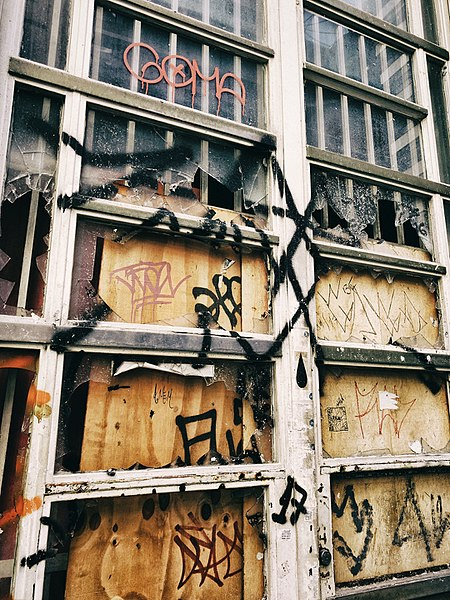5.4 Modern Application: How Is It Relevant Now?
Both strain theories and social disorganization theory are considered classic criminological theories, and they continue to be tested and adjusted. We will address other theories that stem from The Chicago School in other chapters, but this section will provide brief insight into the relevance of the theories discussed in this chapter.
Strain theory is useful for explaining particular types of crime, especially those focused on making money. However, it is less useful for explaining crimes that are non-utilitarian, such as breaking windows, spray painting walls with graffiti, and shoplifting small items that are readily discarded after the act. Another critique of Merton’s theory pertains to crimes committed by bankers and executives. People who engage in corporate crime often have access to institutional means, and many hold degrees from highly respectable universities. In response, Murphy and Robinson (2008) propose an additional mode of adaptation to anomie and strain—maximization—to describe those who combine both legitimate and illegitimate means in their pursuit of wealth and privilege.
The Chicago School approach remains influential today, but there are nevertheless some important limitations to their findings. While the concentric zone model may have worked for Chicago, it is not characteristic of all cities. The idea of disorganization itself has also been criticized. While such neighborhoods may look disorganized to outsiders, for those who live within them, there is a definite order made up of informal associations and networks. Despite these criticisms, Sampson and Groves (1989) provide empirical support for Shaw and McKay’s (1942) approach by measuring the relative degrees of social disorganization within neighborhoods and showing some correlation with respective crime rates.
In relation to the environment and community characteristics as the source of crime, many other theories have evolved that look at the criminality of places rather than people. One example that has been particularly controversial is broken windows theory (Wilson & Kelling, 1982). According to this theory, the environment of a particular space signals its health to the public, including potential vandals (figure 5.13). Environments filled with disorder, such as broken windows or graffiti, indicate an inability for the neighborhood to supervise itself, therefore leading to an increase in criminal activity (Ranasinghe, 2011). The theory posits that by maintaining an organized environment, individuals are dissuaded from causing disarray in that particular location. Instead of focusing on the built environment, policies and practices substantiated by the broken windows theory overwhelmingly emphasize undesirable human behavior as an environmental disorder prompting further crime (Beckett & Herbert, 2008).

For example, civility laws, which originated in the late 1980s and early 1990s, effectively criminalize activities considered undesirable, such as sitting or lying on sidewalks, sleeping in parks, urinating or drinking in public, and begging (Beckett & Herbert, 2010). Civility laws are an attempt to force the individuals doing these and other activities to relocate to the margins of society. Not surprisingly, these restrictions disproportionally affect unhoused people (Beckett & Herbert, 2008). Additionally, the practice referred to as broken windows policing was adopted by law enforcement agencies across the country. Broken windows policing requires police to focus on petty crimes that indicate disorder, with the assumption that this will reduce more violent crime. This form of policing negatively impacts people living in diverse and impoverished communities. Aggressive enforcement through citations or arrests for low-level crimes strained residents’ already thin finances and reduced their trust in the police (Childress, 2016). Overall, this theory and form of policing has been praised and incorporated into many agency’s strategies, but its impact has been disproportionate.
Check Your Knowledge
Licenses and Attributions for Modern Application: How Is It Relevant Now?
Open Content, Original
“Modern Application: How is it Relevant Now? Question Set” was created by ChatGPT and is not subject to copyright. Edits for relevance, alignment, and meaningful answer feedback by Colleen Sanders are licensed under CC BY 4.0.
Open Content, Shared Previously
“Modern Application: How is it Relevant?” is adapted from:
- “Strain Theory,” Introduction to Criminology by Dr. Sean Ashley is licensed under CC BY 4.0, except where otherwise noted. Modifications by Jessica René Peterson, licensed under CC BY 4.0, include shortening for clarity and brevity, combining with other topics, and tailoring to the American context.
- “The Chicago School,” Introduction to Criminology by Dr. Sean Ashley is licensed under CC BY 4.0, except where otherwise noted. Modifications by Jessica René Peterson, licensed under CC BY 4.0, include shortening for clarity and brevity, combining with other topics, and tailoring to the American context.
- “Exclusionary Laws” from Race and Crime [manuscript in press] by Shannell Sanchez and Catherine Venegas-Garcia, Open Oregon Educational Resources, is licensed under CC BY 4.0. Modifications by Jessica René Peterson, licensed under CC BY 4.0, include shortening for clarity and brevity and combining with other topics.
- “Police as Soldiers in the War on Drugs” from Race and Crime [manuscript in press] by Jessica René Peterson, Open Oregon Educational Resources, is licensed under CC BY 4.0. Modifications by Jessica René Peterson, licensed under CC BY 4.0, include shortening for clarity and brevity and combining with other topics.
Figure 5.13. “Broken Windows Theory” by Diego3336 is licensed under CC BY 2.0.

